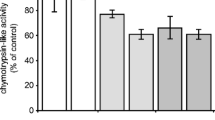Abstract
The ubiquitin-26S proteasome system (UPS) plays a crucial role in selective removal of short-lived target proteins, archiving fine-tuning of post-translation levels of the target proteins. Recently a number of ubiquitin ligases (E3) have been reported as essential regulators of various plant developmental cues and stress responses. To clarify the detailed biochemical and physiological function of the E3 proteins, identification of their target proteins is of great importance. A transient expression system with tobacco leaves is a powerful method to evaluate E3 function and target degradation via UPS. Here simple methods to assay proteasome-dependent protein degradation combined with a tobacco transient expression system and detection of accumulation of ubiquitinated proteins are presented.
Access this chapter
Tax calculation will be finalised at checkout
Purchases are for personal use only
Similar content being viewed by others
References
Hershko A, Ciechanover A (1998) The ubiquitin system. Annu Rev Biochem 67:425–479
Smalle J, Vierstra RD (2004) The ubiquitin 26S proteasome proteolytic pathway. Annu Rev Plant Biol 55:555–590
Stone SL, Callis J (2007) Ubiquitin ligases mediate growth and development by promoting protein death. Curr Opin Plant Biol 10:624–632
Qin F, Sakuma Y, Tran LSP et al (2008) Arabidopsis DREB2A-interacting proteins function as RING E3 ligases and negatively regulate plant drought stress-responsive gene expression. Plant Cell 20:1693–1707
Lee HK, Cho SK, Son O et al (2009) Drought stress-induced Rma1H1, a RING membrane-anchor E3 ubiquitin ligase homolog, regulates aquaporin levels via ubiquitination in transgenic Arabidopsis plants. Plant Cell 21:622–641
Zhang XR, Garreton V, Chua NH (2005) The AIP2 E3 ligase acts as a novel negative regulator of ABA signaling by promoting ABI3 degradation. Genes Dev 19:1532–1543
Sato T, Maekawa S, Yasuda S et al (2011) Identification of 14-3-3 proteins as a target of ATL31 ubiquitin ligase, a regulator of the C/N response in Arabidopsis. Plant J 60:137–146
Liu LJ, Zhang YY, Tang SY et al (2010) An efficient system to detect protein ubiquitination by agroinfiltration in Nicotiana benthamiana. Plant J 61:893–903
Igawa T, Fujiwara M, Takahashi H et al (2009) Isolation and identification of ubiquitin-related proteins from Arabidopsis seedlings. J Exp Bot 60:3067–3073
Sato T, Maekawa S, Yasuda S et al (2009) CNI1/ATL31, a RING-type ubiquitin ligase that functions in the carbon/nitrogen response for growth phase transition in Arabidopsis seedlings. Plant J 60:852–864
Sonoda Y, Sako K, Maki Y et al (2009) Regulation of leaf organ size by the Arabidopsis RPT2a 19S proteasome subunit. Plant J 60:68–78
Book AJ, Smalle J, Lee KH et al (2009) The RPN5 subunit of the 26s proteasome is essential for gametogenesis, sporophyte development, and complex assembly in arabidopsis. Plant Cell 21:460–478
Tsuda K, Qi YP, Nguyen LV et al (2012) An efficient Agrobacterium-mediated transient transformation of Arabidopsis. Plant J 69:713–719
Sakamoto T, Kamiya T, Sako K et al (2011) Arabidopsis thaliana 26S proteasome subunits RPT2a and RPT5a are crucial for zinc deficiency-tolerance. Biosci Biotech Biochem 75:561–567
Acknowledgments
This work was supported by Grants-in-Aid for Scientific Research (23380198, 24114701) to JY, (24770035) to TS; by Research Fellowships from the Japan Society for the Promotion of Science for Young Scientists (2012-2014) to K.S and also by Cooperative Research Grant of the Gene Research Center, the University of Tsukuba.
Author information
Authors and Affiliations
Editor information
Editors and Affiliations
Rights and permissions
Copyright information
© 2014 Springer Science+Business Media, LLC
About this protocol
Cite this protocol
Sato, T., Sako, K., Yamaguchi, J. (2014). Assay for Proteasome-Dependent Protein Degradation and Ubiquitinated Proteins. In: Jorrin-Novo, J., Komatsu, S., Weckwerth, W., Wienkoop, S. (eds) Plant Proteomics. Methods in Molecular Biology, vol 1072. Humana Press, Totowa, NJ. https://doi.org/10.1007/978-1-62703-631-3_45
Download citation
DOI: https://doi.org/10.1007/978-1-62703-631-3_45
Published:
Publisher Name: Humana Press, Totowa, NJ
Print ISBN: 978-1-62703-630-6
Online ISBN: 978-1-62703-631-3
eBook Packages: Springer Protocols




